Cole Slaw & Existential Angst At 12
Saturday, December 05, 2009
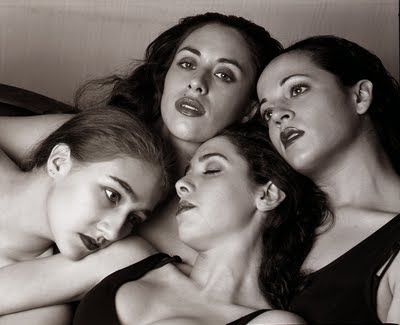
Today Saturday Rebecca, Lauren, Rosemary and I decided to visit the Bloedel Conservatory at Queen Elizabeth Park. Interesting things happened which were going to give me lots to write about. The children and Hilary were picked up late on Saturday night and I simply crashed telling myself I would write the Saturday blog on Sunday morning.
Today Sunday, afternoon, as I prepared myself to process the Tri-X roll of the Bloedel pictures of yesterday I was confronted with a darkroom leak (not a pesky one of light but the more messy one of unwanted water) . It is a perennial one caused by the plumbing industry which helps them create sales even in bad times. The “basket” device that is on both sides of a sink is made of stainless steel on the top side and aluminum on the bottom side. The aluminum corrodes every three to four years perhaps because of my darkroom chemicals. Another reason is that when you combine two metals closely, electricity and other factors do not inhibit corrosion. This is why just about any kitchen dishwasher manual will warn you about mixing metal cutlery with kitchen ware made of other metals.
The plumbing industry would help me avoid my usual week-end plumbing leaks by making that bottom basket out of stainless steel or even of hard plastic. Is this a conspiracy theory rant on my part? No, it is a simple observation. It is an excuse to wait until my sink is fixed (it is but I am waiting for my darkroom to dry a bit before I process that roll of Tri-X) before I place here the pictures of Lauren and Rebecca at the Bloedel Conservatory with that iconic Agave americana (a Mexican agave).
It will suffice for me to put here a portrait of two different sets of Argentine sisters. I only photographed the four and now they are in different places so I will probably not photograph them together again.
The picture of the sisters is justified in that I am citing a project of photographer Nicholas Nixon who in 1975 began taking pictures of his wife with her other three sisters. The project (he continued for at least 25 years) is called The Brown Sisters.
I have been fascinated by the Brown Sisters ever since I saw some of the pictures, and in particular the haunting one, 1982 Ipswich, Massachusetts, in the series many years ago at North Vancouver’s Presentation House.
I have been fascinated because I am a creature of routine. For the last 15 years I have woken up at 6:30 (there have been some exceptions) and I go downstairs to make breakfast for Rosemary and me. It is always the same breakfast. There have been some changes through the years. We used to have bacon on Sundays but we eliminated that custom four or five years ago. My daily tomato juice is affected by Rosemary being able to get it on sale. And the last four months Rosemary has suddenly shifted from hot cream of wheat to sliced bananas with brown sugar. This shift to bananas has been appreciated fully by my garden roses who esteem potassium as a growing supplement.
I feed the two cats. I open the front door and retrieve our Vancouver Sun and the New York Times. I take breakfast and the papers in a wicker tray upstairs where we have breakfast in bed and read the papers. No matter how stressful my life is (and here I can only write about myself since Rosemary does not seem to be able do disconnect her worry switch) I glory in the enjoying of my large mug of very strong and very good black tea, my Venice Bakery scissor rolls (freshly baked in my oven every morning) and the glass of juice while I see and read what has happened around the world. I love this kind of routine.
Routine was in my mind yesterday when I suggested, after lunch (Rebecca pointed out how she liked my cooking and Lauren had three helpings of the beans that I put in the oven with chopped onion, good Parmesan cheese and German Gruyere.) that we visit the birds at the Bloedel Consevatory and take our routine pictures by the agave. Rebecca protested, stamped her feet and had what in Mexico we would call a berrinche. She said that she was tired of doing the same things over and over, of coming to our house on Saturdays and seeing the same films about artists (we saw one on Rembrandt that evening that we all enjoyed). Then she shocked me with, “And then I go home where I feed the Guinea pigs, watch the same TV program and then go to bed and wake up the next day to to the same boring stuff.”
I could not believe it! Existential angst at 12!
In the fall of 1942 Sartre discovered Camus only weeks after sending off the completed manuscript of Being and Nothingness. Coincidentally at the time Sartre wrote a glowing and detailed 6,000-word essay to Camus’ The Stranger. In the essay, Sartre reads The Stranger alongside Camus’ The Myth of Sisyphus. Sartre wrote:
The absurd…resides neither in man nor in the world if you consider each separately. But since man's dominant characteristic is "being-in-the-world," the absurd is, in the end, an inseparable part of the human condition. Thus, the absurd is not, to begin with, the object of a mere idea; it is revealed to us in a doleful illumination. "Getting up, tram, four hours of work, meal, sleep, and Monday, Tuesday, Wednesday, Thursday, Friday, Saturday, in the same routine…," and then, suddenly, "the seeing collapses," and we find ourselves in a state of hopeless lucidity.
It almost sounded like Rebecca’s sudden angst about the uniformity of experience in her life. I was speechless and thought about it during our visit to the Bloedel Conservatory. Somehow she had settled down after demanding that I take her go garting instead of seeing the “same old birds”.
When we returned we had a chat about routine in the living room. I showed her the picture of Quilla that had accidentally been double exposed with a unintended shot at the tea room where I had enjoyed the routine of conversations with my friend Abraham Rogatnick on Wednesdays.
I told Rebecca that routines are never really appreciated until they are lost. We should make it a point to study our routines and appreciate them as they happen and when they happen. She seemed to understand. For the time being it seems that Rebecca has overcome her existential angst.
As for Lauren, she said, "I like your cooking, Papi, but I don't want to eat your cole slaw." Lauren lives a life of absolutes. When will she get her first pangs of existential angst?
Thursday Routine
A Penguin In The Arctic
Friday, December 04, 2009
 In the early 50s Bert Stern, 17, was working in the mailroom of Look Magazine. Delivering letters to the art director of the magazine’s promotion department he looked at a layout and blurted, “There’s a better way to do that.”
In the early 50s Bert Stern, 17, was working in the mailroom of Look Magazine. Delivering letters to the art director of the magazine’s promotion department he looked at a layout and blurted, “There’s a better way to do that.”
“Okay,” the amused art director told the upstart boy with no college, no designing training, “so do it.” Stern had found a teacher. The man’s name was Hershel Bramson. He hauled Stern up from his mailroom work to work as his assistant. Often the two would shut Bramson’s door to talk over a Coke and a handful of Oreo cookies; listening, cutting and pasting, Stern absorbed the elements of design that he now brings to every picture. “If you are going to put something on a very nice piece of clean paper,” Bramson used to tell him, “improve it. Don’t schlock it up.”
In 1955 under contract with Smirnoff Vodka Stern took an idea to the ad agency L.C. Gumbiner on how to convey the driest of martinis.
“What!”the president exclaimed. “Egypt? We don’t want to pay for your vacation.”
“Believe me, “Stern said, “in the middle of summer, Egypt is no vacation.”
“Why don’t you just build a pyramid here in a studio?”
“I don’t know how,” Stern said. “Besides, people will remember the ad if they hear I went all the way to Egypt for it. On top of that, they have an instinct that tells them when something is fake. We all know that pyramid.”
Petersen’s Masters of Contemporary Photography
Bert Stern: How To Turn Ideas Into Images
--------------------------------------------------------------------------------------------------------------------
Since the late 70s when I first purchased the above book about Bert Stern, I have been inspired by all of Stern’s principles for conceptualizing ideas in his head that lead to memorable images.
But I also worry about Stern’s belief in people having an instinct for what is real and for what is fake. Stern’s shot of the ultimate dry martini had the impact that could only happen in a "pre-special effects/Photoshop" era. Now just about anybody can seamlessly place a penguin in the arctic and a polar bear in the Antarctic. Nothing is seen as impossible anymore.
While I never went to Egypt or spent 2 weeks in 140 degree heat on the desert sand I have my own photograph that today would certainly not be conceived and achieved in the same way.

It was sometime in the late 80s that Vancouver Magazine editor Malcolm Parry told me (it was a precise and startling mouthful), “Alex I want you to photograph a Porsche Carrera 4 and a Nissan 300ZX together and moving. I want you to use that Norman flash of yours. I want the cars to be red and I want you to be in one of the cars. I will drive the other.”
I thought Parry was crazy. Why the flash? Was there any purpose in it except to make my task that much more difficult? The startling glow of the resulting picture says something about Parry's talent for pre-visualization.
The first thing I did was to inspect both cars. It was our luck that the dealers had a red Porsche and a red Nissan. The 300ZX’s front end was all plastic. But the Porsche’s had a metal hook for towing it. I could design some sort of clamp that would hold a motorized Nikon FM-2 and Norman 200B light head and battery pack. I needed an extension to make the motor drive cord from the Nikon extend all the way to the interior of the car where I would be riding shotgun. I told Mac that the only way I could get the shot was to buy an expensive (I found a cheaper used one) Nikon fisheye lens.
For close to an hour we went up and down Georgia and the Cambie Street Bridge. We had problems with drivers that would position their cars so as to block my shooting angle. Sometime in the end of the day we had one of those dramatic skies and I got my shot.
Both the shots you see here have no manipulation except the manipulation of neurons in the mind. What will replace that, now that we can put penguins in the arctic and polar bears in the Antarctic?
Yuliya, Quilla, A Canon Pellix & Help From A Dead Friend
Thursday, December 03, 2009

Yesterday I taught my last studio classes for the season at Focal Point. The Contemporary Nude Portrait and Portraiture Through the Ages will meet one more time next Wednesday when we will critique the pictures my students took in the last two weeks. I will miss this bunch as both classes had very good photographers who showed that rare talent that is initiative.
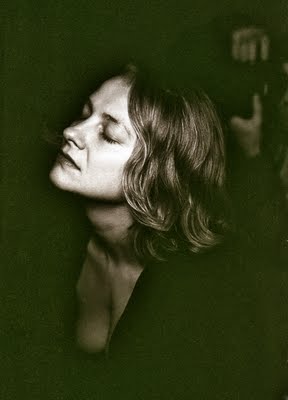
I had an ambivalent problem. I knew that we were going to have two of the best models at Focal Point and both of them would be in both classes. They are Quilla and Yuliya. I have been feeling a bit down and out i wthout my studio and watching my students shoot great models while I supervise. It would take up too much time and it would seem to me a bit unprofessional for me to also hook up to the studio lights and take my own pictures during class time. In the past I have occasionally shot with a small film camera with fast film and taken a few of what we in the business of photography call grab shots. I was ambivalent because I really wanted to take some pictures.
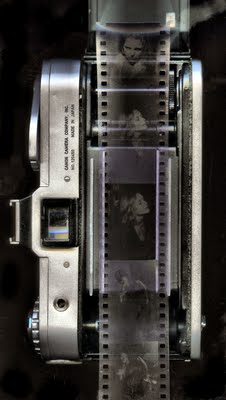
Gerrit te Hennepe, the lawyer of my of my recently deceased friend, Abraham Rogatnick, called me at noon and provided me (I did not know at the time of the call) for a justification to shoot some pictures of Quilla and Yuliya. He called me to tell me he had found a couple of cameras in Abraham’s house and he wanted me to have them as I might find some use for them. I tried to explain to him that film cameras are now obsolete and mostly worthless and that I wanted to get rid of stuff and not acquire more of it.
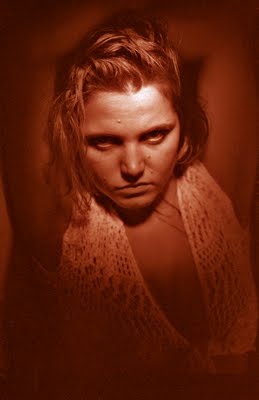
Te Hennepe insisted. I passed by his office which was conveniently a block away from Focal Point. He gave me a box with two cameras. One of them was a Malaysian made, electronic, film Minolta that did not bark because its battery was dead. The other camera was a rare gem that few people would know about.

It was a 1965 vintage Canon Pellix that had the innovation of a partly transparent mirror so that the usual noisy and jarring vibration flip of the mirror up (during the exposure) and then down (after the exposure) was eliminated as the mirror was fixed. Part of the light was diverted to the film and some of the rest to the viewfinder (not all that bright!). The camera failed in spite of this innovation. It was an expensive camera. The elegant mirror that did not move must have appealed to Abraham who had a Bauhaus feel for things as one of his teachers at Harvard was Walter Gropius. The Pellix came with two lenses for which Abraham must have paid a little fortune. One of them was a superb 50mm F-1.4 and the other a startlingly thin profiled “pancake” lens, a 38mm F-2.8. Years ago I had taken some clandestine shots in the Mexican Museum of anthropology (photography was and I believe still prohibited) by hiding a little Pentax MX with a pancake lens inside my jacket.
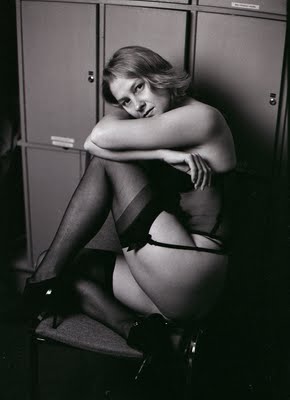
I taught the 2 to 5 nude class and controlled my urge to take pictures. During my break between 5 and 7 I went to the Tea Room across the street on 10th Avenue from Focal Point. Abraham and I used to sit there for at least an hour, sipping African tea and eating the fine pastry made by the Taiwanese/ Brazilian owner. I have been going there and missing Abraham a lot, particularly his intelligent discourse.
I made up my mind that I was going to test the Pellix on Yuliya and Quilla. I practiced putting a roll of Tri-X a few times into the camera until I thought I had down pat the loading mechanism. I snapped the shutter a few times, removed the film and put it back and advanced it to my first exposure for the next class.
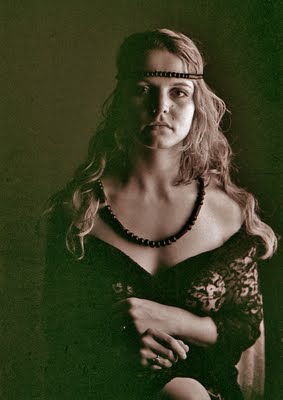
There is a cardinal rule of photography that stipulates that one should never use a camera for something important if the camera has not been used before. So, just to be sure I also loaded a marginally newer Nikon FM-2 with a roll of Tri-X.
I managed to shoot about 6 pictures with the Pellix. Focusing in a dark studio with the dim viewfinder was a challenge but I enjoyed the assertive but still quiet shutter. I took most of the pictures with the Nikon. I processed the film this morning. I had a pleasant surprise that was caused by some serendipity of which if I were to believe in things paranormal I would say that Abraham had a hand in it from the beyond.

Somehow when I snapped the shutter in the tea shop I caught my tea glass, the saucer and the spoon. When I photographed Quilla with it, that image of was on her frame and I had a double exposure. The combination of Quilla and the tea glass was delightful.
There were two more pictures in that Canon Pellix Roll that were killers. One is an almost profile of Yuliya and the other is the nicely scary picture of Quilla that I scanned. For drama I added a red and yellow toning via Photoshop. The rest of the pictures are the more predictable ones taken with my Nikon FM-2. I believe that I just might show off to my student’s in next week’s critique!
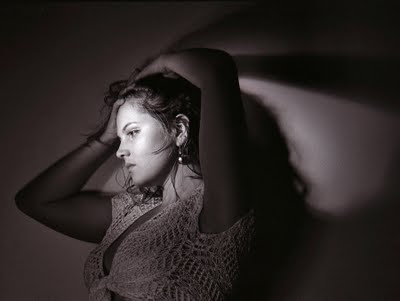
Abraham would have told me, “You should take pictures when you can even if you are the teacher. If you don’t, you're a schmuck.” Thanks to Abraham and his sophisticated klunker I feel as if I were a 20 year-old, all excited about photography as I feast my eyes on the pictures of Quilla and Yuliya.
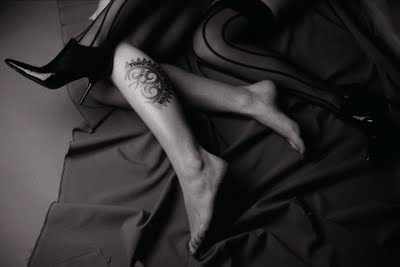
I sent the Quilla and the tea picture to Gerrit who replied:
Dear Alex
Thanks for sending me to first two exposures of your use of the Pellix.............Abraham would have undoubtedly have appreciated the unintended yet creative juxtaposition of the two images.
It is a wonderful picture - the model is beautiful and expressive - and will remind me of you and Abraham........and makes me pleased that you have the camera(s)
Were you working on chiaroscuro?
Gerrit
Technical Information: All pictures were taken either by a Nikon FM-2 with a 50mm F-1.4 or a Canon Pellix with a 50mm F-1.4. I shot Kodak Tri-X pushed to 800 ISO which I processed in Kodak HC-110 Dil 1/39 for 6 minutes 45 seconds.
Naked & Near Naked, Two Nights At The Theatre
Wednesday, December 02, 2009
 This is a pleasant story that begins with a very serious Argentine woman. Nilda Crivelli came to Vancouver this past June as a delegate to the Vancouver World Rose Convention. She was a former president of the Argentine Rose Society. She was formal as many Argentines can sometimes be. I invited her to our rose garden and then we visited Vancouver rosarian Janet Wood with my granddaughter Rebecca. By the end of the day we were caught on one of those bicycle Fridays and we did not move, from our Cardero and Georgia spot for a whole hour. By then Crivelli had lost her Argentine formality and she was laughing as I secretely swore at the cyclists who blocked our way. A few months later she e-mailed me to tell me she had suggested that Martín Flores (a director and playwright of the avant garde in Buenos Aires) look me up when he arrived on an interesting assignment in Vancouver. Flores did contact me and I had him for dinner. It was a treat to be able to converse (over a delicious bottle of Argentine Torrontés wine)in Argentine Spanish with the younger Argentine man. I suggested we meet for a night of theatre at UBC’s Telus Theatre. My friend writer and actor C. C. Humphreys was tackling the principal protagonist of Henrik Ibsen’s The Master Builder. The play was a tad heavy and serious for us but I told Martín that in Vancouver we had a tradition of being able to go back stage to talk to the actors. That cheered us up. We went backstage and caught C.C. Humphreys in the shower. He did allow us to appear with him in his almost near naked Ibsen persona and told me, “I gather this will appear in some blog of yours.” For me the evening was one that I have been digesting since. I had somehow had never seen an Ibsen play. It was a strange experience. My first impression was that Ibsen did not translate too well into the 21st century. Now I am not so sure and I think, that thanks to C.C. Humphreys I am ready for Hedda Gabler. Martín Flores explained to me that by some quirk of fate he had been invited to Vancouver to direct the students of the Eric Hamber Secondary School Theatre Department (Theatre Hamber). I decided to take Rebecca to the opening night, yesterday Tuesday and alas I got my time wrong and we arrived at the intermission. This mistake ended up being a blessing in disguise as I will explain below. Naked, written by the 12 students in the play, and only directed by Martín Flores (As he modestly explained his contribution in what if you happen to know Argentines is most uncharacteristic!) is a terrific set of 12 monologues (with some limited interaction of the other players). The actors reveal up front on a mike some of their pet fears: The One In Love, The One Who Cannot Dancer, The One Who Can’t Stand to be Touched, The One Who Fears Being Buried Alive (extremely Edgar Allan Poeish). In my years of going to terrible high school plays (so as not to offend my daughters) Naked was professional, terrific and best of all my laughs and Rebecca’s were good chicken soup to my lately bluish insides. The man singly responsible for the laughs was John Lee (The One who is Afraid of Many Things), see below in picture with Rebecca and Martin Flores. He has all the makings of natural born stand-up comedian who will make a fortune if his plans to become a nuclear physicist should fail. Lee the man who fears pants that fit and gave us an explanation of why the Chinese might not be able to drive (in involves unicorns and giraffes) delighted us and made Rebecca and I decide that we should return to see the play (all of it!) tomorrow. We will bring along her mother. I look forward to all that laughing. But it wasn’t all laughs. Sarah Trolland (The One in Love) gave a crescendo of a performance where she updated with panache (my view on it) Elizabeth Barrett Browning’s How Do I Love Thee? By the end of her monologue I could see tears in her eyes. As I understand it, her friend Justin Somjen (a precocious student of mine at Focal Point) shed some tears the very same night we were there. We plan to do some more laughing tomorrow. 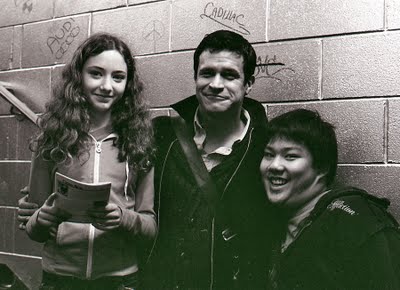 Naked, until December 4th, 7pm (doors open at 6:30) Admission $6.00 Directed by Martín Flores Cárdenas with: Zahra Cully, Alex Dee, (I thought he was cute and when I asked Rebecca she blushed.), Andrew Duffy, Pamela Kennedy, Krystyna Kozlowski, Jon Lee, Ellen MacNevin, Mihajlo Todorovic, Sarah Trolland, Stephen Wong, Holly Zhou.
Andrew Taylor, Esq.
Tuesday, December 01, 2009
 At the last possible moment on Monday I found out I had to teach for 6 hours on Tuesday. That put my blog writing on the back burner until last night (Tuesday) when I managed to find a subject to write about and did so in short minutes. I went to bed with pangs of regret for having thrown away the negatives of La Señorita. This morning I woke up to a pleasant and interesting e-mail communication from Parksville, BC professional photographer Gordon Lafleur who wrote: I find it interesting and charming that the gaze of the lovely Mexican woman on today's entry is the same gaze that appears in most of your grandaughters’ photos.It would seem that Lafleur caught a quirk of mine that I was too close to notice. The pattern was set back then. It was in that unintended class that I taught yesterday at Van Arts (a brand new set of students who all seem to be passionate for photography) that I told my students that for years I have been taking pictures of Rebecca and everybody else, gazing at my camera seriously. I told them that I had borrowed, adapted and made my own the same serious gaze capture that Julia Margaret Cameron so eloquently used in her portraiture. The portraits of Alice Liddell (taken by Cameron when Liddell was an adult) when she seriously posed as a little girl quasi adult for the Reverend Charles Lutwidge Dodgson influenced my approach as did the half century stretch of portraiture by German photographer August Sander.  There was a fundamental reason for the seriousness of early photographic portraiture. To begin with in the painting of portraits few (except for La Joconde) would sit and smile for the length of time needed to render the painting. Serious portraits were the norm. With the advent of photographic portraiture, photographers were plagued with slow lenses and even slower silver sensitized materials. At first the best subjects for these photographers were dead people. Only corpses could remain at rest and not move during those lengthy many minute exposures. As exposures began to shorten devices were still needed to keep portrait subjects at rest. Metal bars attached to their backs and even neck braces were used. In the length of a long exposure the closing of eyes were inconsequential. As the exposures shortened the closing of eyes became a problem.  It was easier, then, for people to gaze, with no smile into the distance. As I sifted through that little leather-bound album of portraits that I had used as a portfolio to get work in the Mexico City of 1974 I found the portrait of my Yorkshire-born friend Andrew Taylor who is the godfather of my eldest daughter Ale. As he gazed seriously into my camera he almost looks like an American Civil War general. This is not an accident. The portraits of that civil war that I saw inside an American Heritage book at the USIS Lincoln Library in Buenos Aires in the early 50s were the ones that awoke my interest in photography. Those civil war generals, as I gazed on them in that first glimpse around 1951 or 52 looked to me like men that I might have seen that same day walking on Calle Florida. 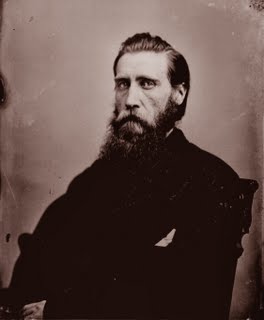 Andrew Taylor with his wild and wide psychedelic tie looks to me like an ever so slightly less-crazed General William Tecumseh Sherman about to embark on his destructive march to the sea. In order of appearance: 1. Andrew Taylor, Esquire 2. General William Tecumseh Sherman 3. General Ulysses S. Grant 4. General John B. Hood (of the Confederate Army)
La Señorita
Monday, November 30, 2009
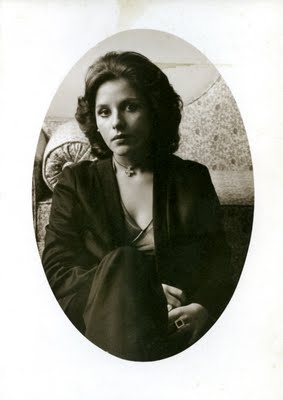 In 1974 my wife and I decided to sell our house, quit our jobs as teachers and move, with our two young daughters from Mexico City to Vancouver. It seemed like a perfect plan except that we had not counted on the problem of not having anybody buy our house. It was not a detached house and it was part of row of houses in the outskirts of Mexico City. Suddenly we had a house we could not sell and no money to pay the mortgage. So I launched my career as a portrait photographer of the wealthy with an Asahi Pentax S-3, a 55mm (Auto-Takumar F-2) lens, a 28mm lens and an 85. I had a home darkroom and I mounted the photographs I took onto cardboard using mounting tissue and an iron. It was fashionable at the time to mount pictures on thick wood and paint edges black. I had no money for lights so I used Kodak Tri-X. My use of an oval brass frame to give my pictures and old look (accentuated with toning my pictures in smelly Kodak Sepia Toner) gave me lots of clients word of mouth from one to the next. I was doing so well that my neighbours suggested I give Mexico another chance. We did not. We finally sold the house and moved to Vancouver. Through the years when I try to compact my files (to borrow computerese language) I throw my negatives away. It was perhaps 10 years ago that I decided that all those Mexicans I had photographed in the posh districts of el Pedregal de San Angel and Las Lomas de Chapultepec had to go. I had some pangs of guilt but I threw the away anyway. I kept the little leather-bound portfolio I used to secure work and I have always been charmed by this señorita with the beautiful chest and the enigmatic face. I remember nothing about her, not even the circumstances that led me to photograph her, so well dressed, leaning against a sofa of a living room. You can see the ravages of time on my print. Stains (sometimes called fixer staing) are appearing on the picture. I do hope that the pictures la señorita purchased are in better shape and that she is a happy woman who has learned to smile.
Of Bats & Cockroaches
Sunday, November 29, 2009
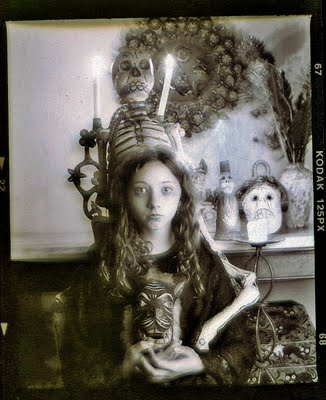 Informe Sobre Ciegos Informe Sobre Ciegos
¡Oh, dioses de la noche!
¡Oh, dioses de las tinieblas, del incesto y del crimen,
de la melancolía y del suicidio!
¡Oh, dioses de las ratas y de las cavernas,
de los murciélagos, de las cucarachas!
¡Oh, violentos, inescrutables dioses
del sueño y de la muerte!
¿Cuándo empezó esto que ahora va a terminar con mi asesinato? Informe Sobre Ciegos, Sobre Héroes y Tumbas Ernesto Sábato, 1961 --------------------------------------------------------------- Argentina is lucky in having more than one definitive Argentine novel. My favourite is Ernesto Sábato's Sobre Héroes y Tumbas , 1961 (On Heroes and Tombs, 1961) which I read in 1964. It left me shattered with its beauty and melancholy. By 1964 the section Informe Sobre Ciegos (Report on the Blind) was famous in all Argentina. This chapter of the novel almost stands alone because of its independence and starkness. It has something to do with a secret society that involves the blind beggars who sell stuff (in my day little ballenitas or plastic stiffeners for dress shirt collars) in Buenos Aires subways and trains. It is staged in a fantastic underworld that coexists with the "real and normal" world. It was in 1965 when I first heard Astor Piazzolla live at the Teatro Florida and fell in love with Susy. I then bought every record of Piazzolla's that I could get my hands on. My favourite has always been Tango Contemporáneo - Astor Piazzolla y Su Nuevo Octeto. It was in this recording that I heard Ernesto Sábato himself read that first incredible paragraph from El Informe de los Ciegos. His voice is strangely pitched and eerily monotone. I replaced the virtually unplayable record with a CD just a few years ago. Even today is sounds avant-garde and fresh. Report on the Blind
Oh gods of the night!
Oh gods of darkness, incest and crime
of melancholy and suicide!
Oh gods of of rats and caverns,
of bats and cockroaches!
Oh violent and inscrutable gods
of dreams and death!
When did this begin which will end with my assassination? Introduction to Report on the Blind from Sobre Héroes y Tumbas, Ernesto Sábato (my translation) You can listen to Ernesto Sábato read that if you wait (be patient!) until the end of this striking composition by Astor Piazzolla here.   Why is Rebecca's photograph here? The moody look of the picture with all the skulls and the candles simply brought to mind this book and also of one of the last books that Sábato may have written (he is alive and 98) Antes Del Fin (Before the End) which is an extremely depressing, but wonderful work of essays on death and the author's reminiscences on his life. The melancholy of the rainy and dark afternoon as I took Rebecca's picture also reminded me of late wintery afternoons in Buenos Aires with my friend Felipe Occhiuzzi. We would sit down on a bench at Parque Lezama and try to imagine two men, one with glasses the other a blind man with a cane, walking, slowly, arm in arm, chatting about novels and writing. The one with the glasses would have been Sábato and the blind man with the cane, Borges.
|




























